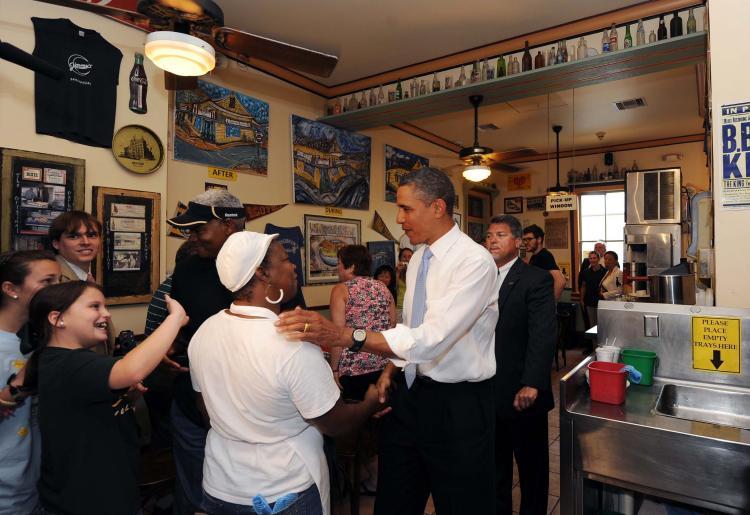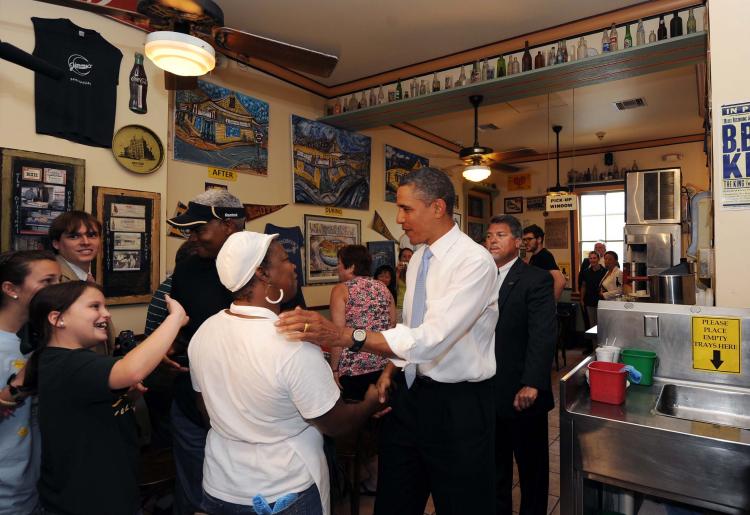President Obama, his family, and many officials spent Sunday in New Orleans commemorating the fifth anniversary of Hurricane Katrina.
He said the city could have remained a symbol of destruction and decay, but that’s not what happened.
“Instead this city has become a symbol of resilience and of community and of the fundamental responsibility that we have to one another.”
The disaster, which destroyed most of New Orleans, still runs emotionally deep with residents. At Xavier University, Obama spoke of the people who lost their lives during the cataclysm and thanked those who helped clean up and rebuild the flooded city.
“We see the dedication to the community in the efforts of Xavier grad Dr. Regina Benjamin, who mortgaged her home, maxed out her credit cards so she could reopen her Bayou la Batre clinic to care for victims of the storm—and who is now our nation’s Surgeon General,” said Obama.
It is no coincidence that the commemoration was held at Xavier University. During the 2005 flood the school was nearly destroyed. It has become a symbol of New Orleans’ drive to recover. For two weeks after the storm the university was under water. Faculty and students scattered. The future of New Orleans looked bleak.
People pushed away by the floods soon returned and began rebuilding the school. By the next semester, January 2006, 80 percent of Xavier students had returned. The school needed vast cleanup and repairs, but current enrollment figures show that the university made a full recovery.
“What happened to New Orleans represents the greatest disaster this country has ever had. That we were able to come back in such a short period of time is a credit to the faith, commitment, and passion of our staff and faculty, who put aside their personal losses and problems to make this miracle happen,” said university President Norman Francis in a press release.
The White House released a statement saying that it is hard to imagine a worse disaster because this affected so many people and left such a huge wake of destruction. The administration has committed to reducing red tape that holds progress back.
The severe oil spill this summer brought more attention to the Gulf Coast. The president, the vice president, cabinet officials, and officials from government agencies including FEMA have visited the area 155 times and given nearly $2.42 billion for Louisiana and Mississippi.
This administration has also pledged to improve our emergency response system so that future disasters will have less of an impact, according to the White House.
Members of the cabinet and senior agency leaders including Housing and Urban Secretary Shaun Donovan, FEMA Administrator Craig Fugate, EPA Administrator and New Orleans native Lisa Jackson, and CNCS CEO Patrick Corvington, and first lady Michelle Obama met with local citizens including Xavier University students and staff, local and state officials and politicians, and the general public on the anniversary of the storm.
Governor Bobby Jindal, senators Mary Landrieu and David Vitter, and congressmen Joe Cao, Charlie Melancon, and Steve Scalise also attended the event.
He said the city could have remained a symbol of destruction and decay, but that’s not what happened.
“Instead this city has become a symbol of resilience and of community and of the fundamental responsibility that we have to one another.”
The disaster, which destroyed most of New Orleans, still runs emotionally deep with residents. At Xavier University, Obama spoke of the people who lost their lives during the cataclysm and thanked those who helped clean up and rebuild the flooded city.
“We see the dedication to the community in the efforts of Xavier grad Dr. Regina Benjamin, who mortgaged her home, maxed out her credit cards so she could reopen her Bayou la Batre clinic to care for victims of the storm—and who is now our nation’s Surgeon General,” said Obama.
It is no coincidence that the commemoration was held at Xavier University. During the 2005 flood the school was nearly destroyed. It has become a symbol of New Orleans’ drive to recover. For two weeks after the storm the university was under water. Faculty and students scattered. The future of New Orleans looked bleak.
People pushed away by the floods soon returned and began rebuilding the school. By the next semester, January 2006, 80 percent of Xavier students had returned. The school needed vast cleanup and repairs, but current enrollment figures show that the university made a full recovery.
“What happened to New Orleans represents the greatest disaster this country has ever had. That we were able to come back in such a short period of time is a credit to the faith, commitment, and passion of our staff and faculty, who put aside their personal losses and problems to make this miracle happen,” said university President Norman Francis in a press release.
The White House released a statement saying that it is hard to imagine a worse disaster because this affected so many people and left such a huge wake of destruction. The administration has committed to reducing red tape that holds progress back.
The severe oil spill this summer brought more attention to the Gulf Coast. The president, the vice president, cabinet officials, and officials from government agencies including FEMA have visited the area 155 times and given nearly $2.42 billion for Louisiana and Mississippi.
This administration has also pledged to improve our emergency response system so that future disasters will have less of an impact, according to the White House.
Members of the cabinet and senior agency leaders including Housing and Urban Secretary Shaun Donovan, FEMA Administrator Craig Fugate, EPA Administrator and New Orleans native Lisa Jackson, and CNCS CEO Patrick Corvington, and first lady Michelle Obama met with local citizens including Xavier University students and staff, local and state officials and politicians, and the general public on the anniversary of the storm.
Governor Bobby Jindal, senators Mary Landrieu and David Vitter, and congressmen Joe Cao, Charlie Melancon, and Steve Scalise also attended the event.






